Essay Draft Comments: What Do We Owe Students?
Recently, I’ve been reflecting on the whole purpose of written feedback.
For one thing, it can be frustrating, spending time on articulating suggestions for improvement, and then watching the student flip to the end of their draft to read the grade. Then put the paper away. Or flat-out chuck it in the trash. Even more frustrating when they stop by during office hours to ask how they could bring up their grade.
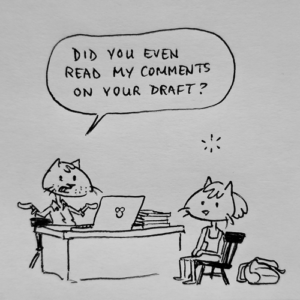
For another thing, I do a lot of my grading in Google Drive these days. There are some real benefits. You can pop in and comment in the same document along multiple points of the process. During drafting, during a “write-in” period, during conferences, after a draft is submitted.
But on the flip side, I’ve written a lot of comments in Google Drive that I’m sure my students never read. And sometimes, they come by wondering what grade they got. They clearly never even opened the document after I graded it.
But all of those frustrations are my problems, not my students’ problems. I don’t like the idea that my brilliant feedback isn’t been taken into consideration. I even take it personally sometimes.
But I know that’s self defeating.
So, I started to ask myself the following questions:
- How does a student experience written feedback?
- What is the end of written feedback?
- What feedback do we owe each student?
And I realized that the amount of comments and feedback should actually be scaled. I don’t mean more comments for students who need more help. I mean scale your comments in relation to a very specific goal. For instance, say the goal is to improve the assignment by one letter grade.
In other words, we don’t owe every student the revision suggestions that would raise the grade to an A.
Here’s my reasoning.
Say the student gets a D on her rough draft. Then suppose I write her some feedback outlining all the things she could improve on for the final draft.
What I think we need to consider is how the student would perceive those comments. Probably, the student perceives them as aiming the final draft towards a perfect score, or an A. Something like this:
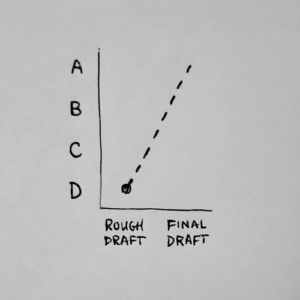
I’ve had students complain that they’ve done the revisions–so why did they only get a B+ on the final draft? This question (and the sense of betrayal) comes from that assumption. That our feedback is a map toward an A.
The problem is, to the D-student, that’s a disheartening picture. I mean, look at that super-scientific graph. That’s too steep a climb. Really, the task I’m setting in front of the student is this:
“Hey! Sort out all this feedback and form an action plan and attack the suggested revisions one at a time. Climb that mountain, build some character!”
And the D-student is not likely to have the experience or readiness to do that, or even understand that this is what I’m asking them to do.
So here’s an alternate scenario:
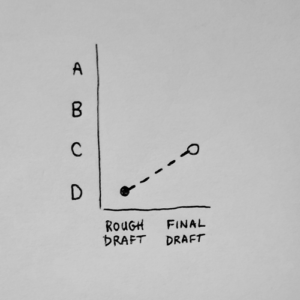
Say I write a few comments, aiming the student at bringing their grade up from a D to a C. And I explicitly state that this is what I’m doing.
Then it’s not too steep a climb. It’s manageable. There’s an end in sight. Call it Base Camp #2.
Furthermore, the task I’m setting in front of the student is much clearer:
“Hey! Here’s an action plan to get your next draft up to a C-range grade.”
And here’s another implication:
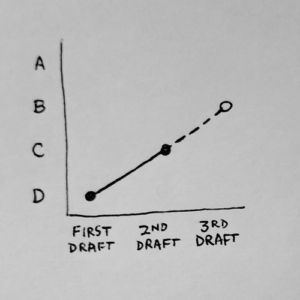
There’s room to grow.
Say the student does the work, and gets their grade up to a C. Why stop there? Think about how this feedback system could, by having a gentler slope, encourage an underachieving student to push on to a third, optional draft.
Yes, you have another draft to grade. But you have a student opting to revise their work.
Of course, this feedback framework begs a couple questions.
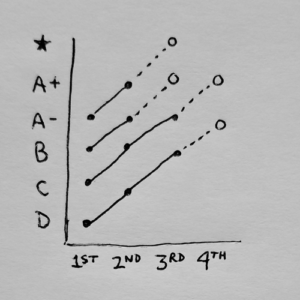
Like, will you be forever grading revisions?
If your average draft grade is say, a B-, for the most part you’re looking at students doing one required revision and one optional revision. Again, it looks like a bit more work for you.
But it’s smarter work than just steep-climb feedback on every rough draft.
Another question: should you push A-range students toward a third or fourth draft?
Yes. That “★” on my little chart is a suggestion. The places you could go after A+. The Realm Beyond Grades. All kinds of wonderful things lie there.
I can give you a concrete example. I have a student right now who earned a B+ on his rough draft. He revised it up to an A+ second draft. Then he said, “I want to get this essay published.”
Wow! The Realm Beyond Grades.
Of course I said yes, let me help you with the process of researching markets, revising for publication, and assembling a submission package. Let’s do this!
